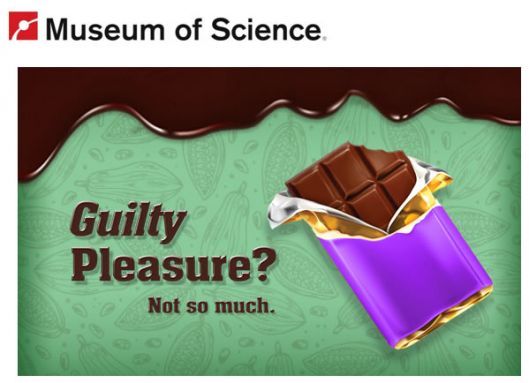
The Museum of Science, Boston unveils its newest exhibition, Chocolate, exploring every aspect of “the world’s perfect food," so described by nutrition researcher Michael Levin. The 5,000-square-foot exhibit examines chocolate’s unique place in history, ecology and popular culture. It reveals where chocolate is grown and how it’s made, from the most luxurious confections to the mass-produced treats doled out on Halloween.
"Through this dynamic exhibit, visitors will experience chocolate from its rich history—which goes back thousands of years—to its global influence and universal popularity," says Christine Reich, the Museum’s vice president of exhibits development and conservation.
The interactive exhibit delves into chocolate’s place in ancient and contemporary societies, its significant economic impact and its starring role in the culinary arts.
The exhibit takes Museum guests deep within the complex rainforest ecosystem with a replica of a native cacao tree laden with football-shaped seed pods (Theobroma cacao translates to cacao, food of the gods.). Found in Central and South America, Asia and West Africa, these evergreens reach no more than 40 feet in height, growing in the shade of the much larger canopy trees. Visitors will appreciate the importance of midges, the tiny no-see-um flies that pollinate the delicate flowers which grow directly on the trunk and lower limbs of the cacao tree, and the migrating birds that build homes in its branches.
Created by Chicago’s Field Museum, Chocolate explores the ancient Maya—the first to transform the bitter seeds into a spicy drink made from crushed, fermented, dried and roasted cacao, chili peppers, and water—and the Aztec empire where cacao was considered both an offering to the gods and a form of currency.
Chocolate, located in the Museum’s Blue Wing, focuses on the Spanish conquest of the Americas, the treasure-trove of seeds they discovered and the arrival of chocolate in Europe. Here, visitors will see what happened when cacao was first combined with sugar and how the wealthy satisfied their cravings for all things chocolate while enslaved peoples toiled on plantations to meet the growing European demand.
This exhibit reflects the Museum’s commitment to educating the public about food and nutrition. According to Museum president and director Ioannis Miaoulis, “Chocolate is a natural extension of our efforts to present the science and engineering behind agriculture and nutrition, the importance of food in history and society and the work of some of the world’s gastronomic wizards. This timely exhibit engages the senses and highlights the importance of chocolate which is enjoyed in every corner of the globe.” Presented in English and Spanish, Chocolate reveals the sweet side of the industrial revolution, the inventions, advertising and packaging that brought chocolate in myriad shapes and sizes to the masses, and the backbreaking work needed to harvest cacao.
Museum-goers will see the impact of this important product in the global economy, estimated at more than $90 billion annually. Today, cacao seeds are traded on the commodities market, under the name cocoa, along with wheat, pork bellies and soybeans. A futures stock ticker in the exhibit will display current cocoa prices on the world market.
Harvesting cacao is a labor-intensive undertaking. Each pod contains from 30 to 50 seeds, just enough to produce a few bars of chocolate. Museum-goers will discover how chocolate is grown, gathered, shipped, sold and consumed, and learn how farmers are working to maintain their crops to protect their income, preserve their way of life and protect the rainforest. These farmers are partnering with scientists to incorporate ecologically sound and sustainable practices and eliminate the use of fertilizers and pesticides which are toxic to people and vegetation.
Chocolate is included with regular Exhibit Halls admission: $25 for adults, $21 for seniors (60+), and $20 for children (3-11). For more information, call 617/723-2500 or visit www.mos.org.
Chocolate and its national tour were developed by The Field Museum, Chicago, and supported, in part, by the National Science Foundation.
About the Museum of Science, Boston
One of the world's largest science centers and New England's most attended cultural institution, the Museum introduces more than 1.5 million visitors a year to STEM (science, technology, engineering and math) through the world-class interactive exhibits, programs and K-12 curricula of its William and Charlotte Bloomberg Science Education Center. An extraordinary variety of learning experiences span the Yawkey Gallery on the Charles River, Hall of Human Life, Thomson Theater of Electricity, Charles Hayden Planetarium, Mugar Omni Theater, Gordon Current Science & Technology Center, 4-D Theater, and Butterfly Garden. The Science Behind Pixar, created with Pixar Animation Studios, is touring nationally. The Museum's National Center for Technological Literacy® K-12 curricula, including its award-winning Engineering is Elementary®, have reached an estimated 13 million students and 129,700 educators. The Museum sparks teens worldwide to use digital technology via The Clubhouse Network and has led a $41 million National Science Foundation-funded Nanoscale Informal Science Education Network of science museums and university research centers. Visit: http://www.mos.org.
One of the world's largest science centers and New England's most attended cultural institution, the Museum introduces more than 1.5 million visitors a year to STEM (science, technology, engineering and math) through the world-class interactive exhibits, programs and K-12 curricula of its William and Charlotte Bloomberg Science Education Center. An extraordinary variety of learning experiences span the Yawkey Gallery on the Charles River, Hall of Human Life, Thomson Theater of Electricity, Charles Hayden Planetarium, Mugar Omni Theater, Gordon Current Science & Technology Center, 4-D Theater, and Butterfly Garden. The Science Behind Pixar, created with Pixar Animation Studios, is touring nationally. The Museum's National Center for Technological Literacy® K-12 curricula, including its award-winning Engineering is Elementary®, have reached an estimated 13 million students and 129,700 educators. The Museum sparks teens worldwide to use digital technology via The Clubhouse Network and has led a $41 million National Science Foundation-funded Nanoscale Informal Science Education Network of science museums and university research centers. Visit: http://www.mos.org.
When:
Exhibiting now through May 7, 2017 from 9:00 am – 5:00 pm
Location:
Phone:
617-723-2500
Email:
Link(s):





















